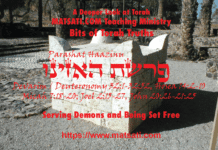This week’s reading is from Parashat Tazria (Vayikra / Leviticus 12:1-13:59) the Lord speaks to Moshe on the topic of uncleanness. When a woman gives birth she will be unclean for seven days similar to the days of her menstruation (12:1-2). The eighth day the child is to be circumcised (12:4). Following the birth, the woman is to remain in the blood of her purification for thirty days and she is not to touch any consecrated thing nor enter into the sanctuary until the days of her purification are complete (12:4). This is the case for if she bears a male child. If she bears a female child these times are doubled, she will be unclean for two weeks and remain in the blood of her purification for two months (60 days). After this time, the woman is to bring a young lamb as an Olah Korban (Whole burnt offering) before the Lord and this is used to cleanse her for the flow of her blood. If she cannot afford the lamb, she is to bring two turtle doves or two pigeons for a sin offering (12:5-8). The Lord then commands Moshe to speak to the people concerning the disease of Tzaraat (Leprosy). The Cohen (Priest) is to inspect the person showing the signs of Tzaraat (13:1-46). The person found to have Tzaraat then is to remain outside of the camp and the Scriptures say מד אִישׁ-צָרוּעַ הוּא טָמֵא הוּא טַמֵּא יְטַמְּאֶנּוּ הַכֹּהֵן בְּרֹאשׁוֹ נִגְעוֹ: מה וְהַצָּרוּעַ אֲשֶׁר-בּוֹ הַנֶּגַע בְּגָדָיו יִהְיוּ פְרֻמִים וְרֹאשׁוֹ יִהְיֶה פָרוּעַ וְעַל-שָֹפָם יַעְטֶה וְטָמֵא | טָמֵא יִקְרָא: מו כָּל-יְמֵי אֲשֶׁר הַנֶּגַע בּוֹ יִטְמָא טָמֵא הוּא בָּדָד יֵשֵׁב מִחוּץ לַמַּחֲנֶה מוֹשָׁבוֹ: 13:45 ‘As for the leper who has the infection, his clothes shall be torn, and the hair of his head shall be uncovered, and he shall cover his mustache and cry, ‘Unclean! Unclean!’ 13:46 ‘He shall remain unclean all the days during which he has the infection; he is unclean. He shall live alone; his dwelling shall be outside the camp. (NASB) The Lord goes on stating that a garment (wool, linen, or leather) is also able to contract Tzaraat (13:47). These linen garments are quarantined for seven days and reexamined to see if the Tzaraat is spreading. This most likely is a fungal mold that may be very hazardous to our health. If the garment is found to contain Tzaraat it is to be burned with fire (13:51-52). When the Cohen looks and the Tzaraat in the garment has not spread, the garment is washed and if the spot remains, the garment is to be declared unclean and it is to be burned with fire (13:55, נה וְרָאָה הַכֹּהֵן אַחֲרֵי | הֻכַּבֵּס אֶת-הַנֶּגַע וְהִנֵּה לֹא-הָפַךְ הַנֶּגַע אֶת-עֵינוֹ וְהַנֶּגַע לֹא-פָשָֹה טָמֵא הוּא בָּאֵשׁ תִּשְֹרְפֶנּוּ פְּחֶתֶת הִוא בְּקָרַחְתּוֹ אוֹ בְגַבַּחְתּוֹ:). If the mark is faded after washing, the mark is to be torn out of the garment, washed a second time, and inspected to be certain the Tzaraat has not reappeared in the garment (13:56-59). According to the Scriptures, the garment is to be carefully inspected by the Cohen. מח אוֹ בִשְׁתִי אוֹ בְעֵרֶב לַפִּשְׁתִּים וְלַצָּמֶר אוֹ בְעוֹר אוֹ בְּכָל-מְלֶאכֶת עוֹר: מט וְהָיָה הַנֶּגַע יְרַקְרַק | אוֹ אֲדַמְדָּם בַּבֶּגֶד אוֹ בָעוֹר אוֹ-בַשְּׁתִי אוֹ-בָעֵרֶב אוֹ בְכָל-כְּלִי-עוֹר נֶגַע צָרַעַת הוּא וְהָרְאָה אֶת-הַכֹּהֵן: 13:48 whether in warp or woof, of linen or of wool, whether in leather or in any article made of leather, 13:49 if the mark is greenish or reddish in the garment or in the leather, or in the warp or in the woof, or in any article of leather, it is a leprous mark and shall be shown to the priest. (NASB) Studying the text very carefully, we find Marcus Jastrow lexicon on the word בִשְׁתִי translates as “to lay the foundation, fix the warp, start the loom,” and “to weave, in the mixture of the flax” in addition to this the scripture describes the “boundary, border” (בְעֵרֶב לַפִּשְׁתִּים), the “wool, fleece, pelage” (וְלַצָּמֶר), “in the skin” (בְעוֹר), and “in all the work of the skin” (אוֹ בְּכָל-מְלֶאכֶת עוֹר) in the details of the inspection. The Cohen inspects down to the very foundation of the clothing, the connecting materials, the flax and wool the manufacturing and the weaving of the linens that hold it together which make up the garment. This describes that a very careful inspection is conducted. In a similar way we need to inspect our lives very carefully. Are there things in our lives were sin lays a foundation of rottenness making us unclean before the Lord? Tzaraat was a disease that only God could heal and we will learn that the healing of Tzaraat in and of itself was a sign that the Messiah has come! Read More here.








